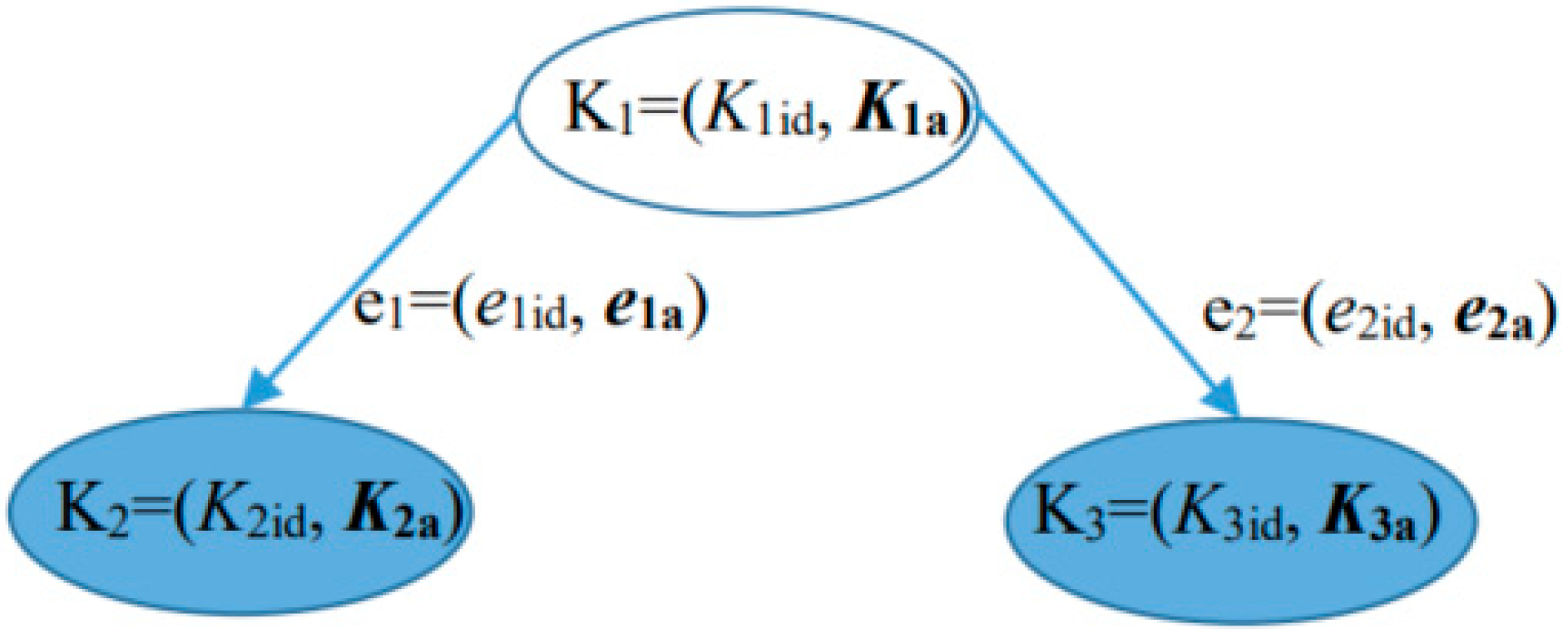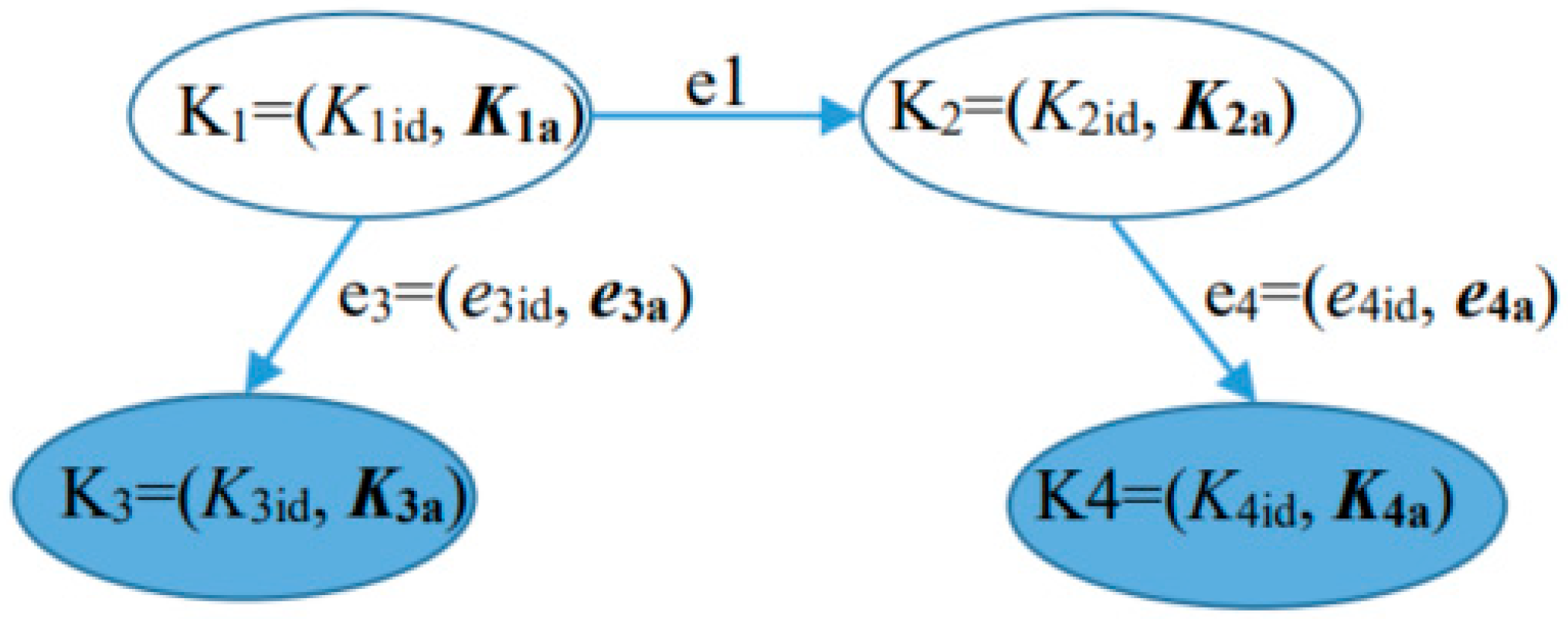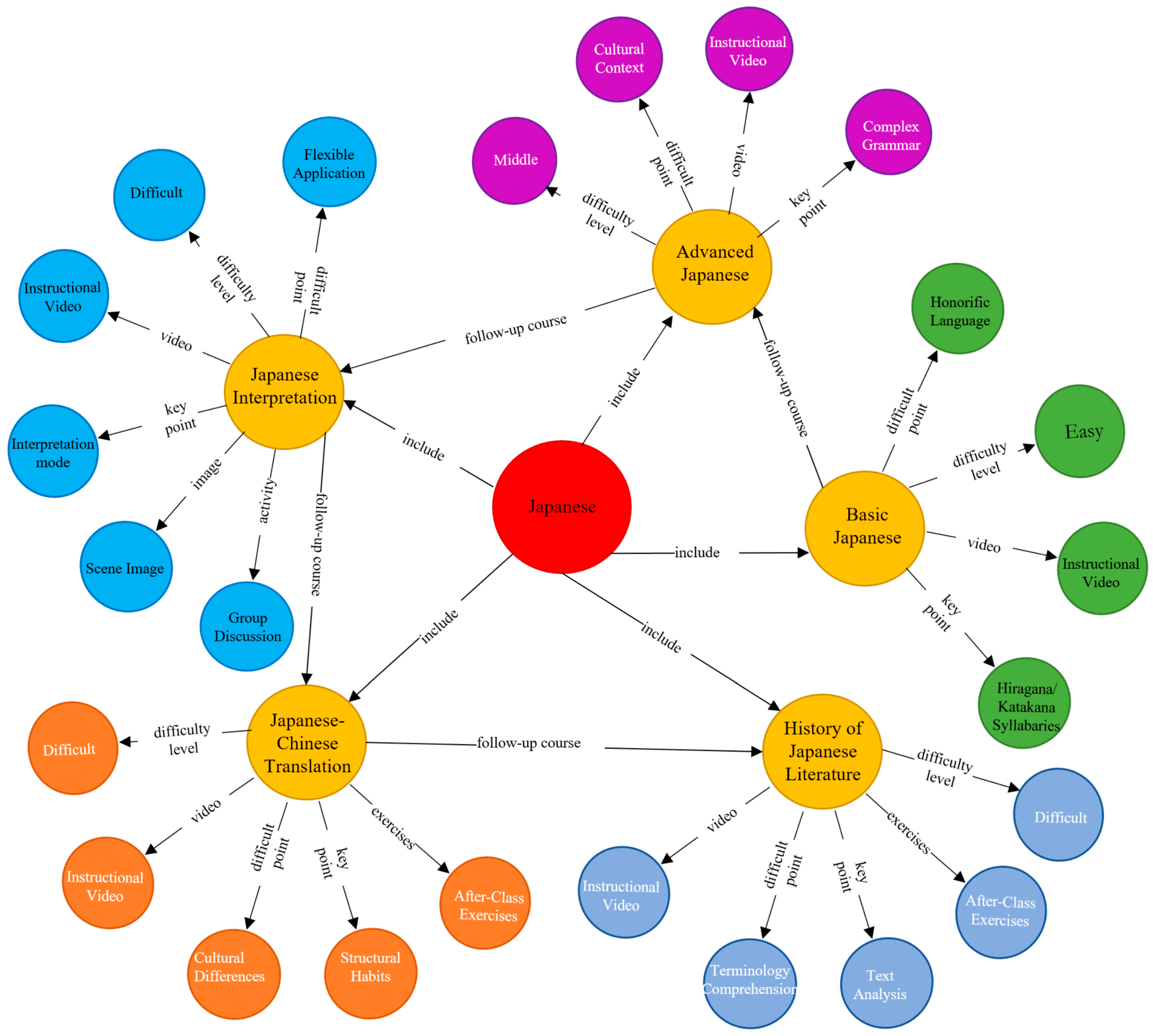A Symmetry Analysis Method for Teaching Knowledge Graph Evolution Driven by Directed Attributed Graphs
Abstract
1. Introduction
- (1)
- A directed attributed graph-based model for educational knowledge graphs is proposed, and four types of symmetry, namely entity connection symmetry, entity central symmetry, entity mirror symmetry, and structural symmetry, are formally defined based on directed attributed graphs.
- (2)
- A teaching knowledge graph evolution method based on directed attributed graph transformation is designed. Three graph-based evolution rules—addition, replacement, and deletion of teaching entities—are introduced, and a rule-driven algorithm for evolving teaching knowledge graphs is presented.
- (3)
- Basic conditions for the preservation and breaking of entity connection symmetry, entity central symmetry, entity mirror symmetry, and structural symmetry in the evolution of educational knowledge graphs based on the directed attributed graph model are provided, and it is experimentally verified that the preservation or breaking of these symmetries has a significant impact on the connectivity and path complexity of knowledge graphs.
2. Related Work
3. Definition of Symmetric and Asymmetric Graph Models for Teaching Entities
3.1. Definition of Directed Attributed Graph and Graph Transformations
3.2. Definition of Entity Symmetry and Asymmetry
4. Directed Attributed Graph-Driven Evolution Rules and Methods for Teaching Knowledge Graph
4.1. Teaching Entity Addition Evolution Rule
4.2. Teaching Entity Replacement Evolution Rule
4.3. Teaching Entity Deletion Evolution Rule
4.4. A Graph Model-Driven Approach to the Evolution of Teaching Knowledge Graph
| Algorithm 1: Evolution of Teaching Knowledge Graph, ETKG |
| Input: Teaching Knowledge Graph GK = (V, E, AV, AE, A, E), pi: L→R |
| Output: New Teaching Knowledge Graph = (V, E, AV, AE, A, E) |
| 1: FChecking_conflict(pi, pj) |
| 2: if (F = true) |
| 3: Conflict_resolution_strategy(pi, pj) |
| 4: else//Concurrent execution rules |
| 5: get left_rule L from pi: L→R and pi: L→R |
| 6: while concurrent traversing nodes not completed do |
| 7: if L match in GK |
| 8: cut L in GK |
| 9: GKGK–L |
| 10: get right_rule R from pi: L→R |
| 11: paste R in GK |
| 12: GK R |
| 13: return |
| 14: else if L no match in GK |
| 15: return No_match_L |
5. Symmetry Preservation and Breakage in the Evolution of Teaching Knowledge Graph
- (1)
- When n = 0, no evolution has been performed, so remains the initial educational knowledge graph. By the assumption of the proposition, exhibits entity connection symmetry, central symmetry, mirror symmetry, and structural symmetry. Hence, the proposition holds for n = 0.
- (2)
- When n > 0, assume that after w evolution steps, the knowledge graph retains entity connection symmetry, central symmetry, mirror symmetry, and structural symmetry. We now consider the transition from step w to step w + 1. Suppose a replacement rule p2 is applied to to obtain . According to the definition of rule p2, only the local substructure {K2, e1} is replaced by {K3, e2}, while all other parts remain unchanged. Since AV(K2) = AV(K3) and AE(e2) = AE(e3), the new substructure is attribute-wise and connectivity-wise equivalent to the original one, i.e., structurally equivalent. Therefore, also maintains entity connection symmetry, central symmetry, mirror symmetry, and structural symmetry.
6. Evaluation and Illustrative Examples of the Impact of Preserving and Breaking Symmetry in Educational Knowledge Graph Evolution
6.1. Analysis of the Impact of Symmetry Preservation and Breaking in Educational Knowledge Graph Evolution
6.1.1. Evaluation Metrics for Symmetry Preservation and Breaking
6.1.2. The Impact of Evolution on Connectivity and Path Complexity
6.2. Symmetric and Asymmetric Case Analysis of Teaching Knowledge Graph Evolution in Japanese Language Major
6.2.1. Directed Attributed Graph Model of the Teaching Knowledge Graph for Japanese Language Major
6.2.2. Analysis and Discussion on Symmetry Preservation in the Evolution of the Teaching Knowledge Graph for the Japanese Language Major
6.2.3. Analysis and Discussion on Symmetry Breakage in the Evolution of the Teaching Knowledge Graph for the Japanese Language Major
7. Conclusions
Author Contributions
Funding
Data Availability Statement
Acknowledgments
Conflicts of Interest
References
- Chen, G.Y.; Song, T.; Wang, Q.Y.; Ma, Z.; Hu, J.; Li, Q.; Wu, C.M. Knowledge Graph and Large Language Model Integration with Focus on Educational Applications: A Survey. Neurocomputing 2025, 654, 131230. [Google Scholar] [CrossRef]
- Li, Y.; Liang, Y.; Yang, R.; Zhang, C.; Zhang, X. CourseKG: An Educational Knowledge Graph Based on Course Information for Precision Teaching. Appl. Sci. 2024, 14, 2710. [Google Scholar] [CrossRef]
- Xiao, Z.; Yang, Z.; Li, Y.; Hu, Z. English Online Education Resource Recommendation Using Knowledge Graph and ARA Algorithm. J. Comp. Methods Sci. Eng. 2025, 25, 2209–2222. [Google Scholar] [CrossRef]
- Gao, X. Design and Implementation of a Knowledge Graph-Based Teaching Assistance System for English Courses in Colleges and Universities. In Proceedings of the 2nd International Conference on Digital Media, Communication and Information Systems (DMCIS), Nanjing, China, 20–22 June 2025; pp. 105–108. [Google Scholar]
- Zhang, M.H.; Zhang, M.C. Research on the Application of Knowledge Graph in Teaching-Taking “Edge Computing and Intelligent Vision Application” Course as an Example. In Proceedings of the 13th International Conference on Educational and Information Technology (ICEIT), Chengdu, China, 22–24 March 2024; pp. 356–360. [Google Scholar]
- Guo, Y. Construction of Adaptive Evaluation Model of Educational Knowledge Structure Integrating Knowledge Graph and Convolutional Neural Network. In Proceedings of the 5th International Conference on Information Science and Education (ICISE-IE), Zhanjiang, China, 20–22 December 2024; pp. 78–83. [Google Scholar]
- Ge, L.P.; Huang, Z.H. Research on the Construction of Knowledge Graphs for Text-Based English Teaching Mining Based on Deep Learning. In Proceedings of the 5th Asia-Pacific Conference on Communications Technology and Computer Science (ACCTCS), Shenyang, China, 23–25 April 2025; pp. 938–942. [Google Scholar]
- Wu, D.; Hu, S.; Hu, L.Z.; Hu, J.H.; Zhi, H.; Li, X.W. Teaching Practice Evaluation of Medical Mathematical Statistics Based on Knowledge Graph. In Proceedings of the 5th International Conference on Artificial Intelligence and Education (ICAIE), Suzhou, China, 14–16 May 2025; pp. 852–855. [Google Scholar]
- Yang, Z.; Hu, J.; Zhong, S.; Yang, L.; Min, G. Graph-Based Effective Knowledge Tracing Via Subject Knowledge Mapping. Educ. Inf. Technol. 2025, 30, 9813–9840. [Google Scholar] [CrossRef]
- Yang, E.; Hao, F.; Gao, J.; Wu, Y.; Min, G. Entity Spatio-temporal Evolution Summarization in Knowledge Graphs. In Proceedings of the IEEE International Conference on Knowledge Graph (ICKG), Nanjing, China, 9–11 August 2020; pp. 181–187. [Google Scholar]
- Ning, J.; Liu, R.; Wang, X.; Dai, M. Temporal Correlation Embedding for Enhanced Temporal Knowledge Graph Evolution. In Proceedings of the 5th International Conference on Artificial Intelligence, Big Data and Algorithms (CAIBDA), Beijing, China, 20–22 June 2025; pp. 379–384. [Google Scholar]
- Yang, H.L.; Hu, S.Z.; Geng, J.; Huang, T.; Hu, J.; Zhang, H.; Zhu, Q. Heterogeneous Graph-Based Knowledge Tracing with Spatiotemporal Evolution. Exp. Syst. Appl. 2024, 238, 122249. [Google Scholar] [CrossRef]
- Liu, Q.; Feng, S.; Huang, M.; Bhatti, U.A. Temporal Knowledge Graph Representation Learning with Temporal Feature and Complex Evolution. Int. J. Mach. Learn. Cybern. 2025, 16, 6347–6365. [Google Scholar] [CrossRef]
- Cao, S.; Wang, X.; Ye, Z.; Li, M.; Zhao, H. LGNN: A Novel Linear Graph Neural Network Algorithm. Front. Comput. Neurosci. 2023, 17, 1288842. [Google Scholar] [CrossRef] [PubMed]
- Li, X.; Tang, G. Multivariate Sequence Prediction for Graph Convolutional Networks Based on ESMD and Transfer Entropy. Multimed. Tools Appl. 2024, 83, 83493–83511. [Google Scholar] [CrossRef]
- Xu, X. Symmetry-Driven CTDE: Enhancing Scalability and Sample Efficiency in MARL. In Proceedings of the 10th International Conference on Intelligent Computing and Signal Processing (ICSP), Xi’an, China, 16–18 May 2025; pp. 744–748. [Google Scholar]
- Drexler, D.; Sthlberg, S.; Bonet, B.; Geffner, H. Symmetries and Expressive Requirements for Learning General Policies. In Proceedings of the 21 International Conference on Principles of Knowledge Representation and Reasoning, Hanoi, Vietnam, 2–8 November 2024; pp. 845–855. [Google Scholar]
















Disclaimer/Publisher’s Note: The statements, opinions and data contained in all publications are solely those of the individual author(s) and contributor(s) and not of MDPI and/or the editor(s). MDPI and/or the editor(s) disclaim responsibility for any injury to people or property resulting from any ideas, methods, instructions or products referred to in the content. |
© 2025 by the authors. Licensee MDPI, Basel, Switzerland. This article is an open access article distributed under the terms and conditions of the Creative Commons Attribution (CC BY) license (https://creativecommons.org/licenses/by/4.0/).
Share and Cite
Zou, Q.; Lu, C.; Sun, Y. A Symmetry Analysis Method for Teaching Knowledge Graph Evolution Driven by Directed Attributed Graphs. Symmetry 2025, 17, 2009. https://doi.org/10.3390/sym17112009
Zou Q, Lu C, Sun Y. A Symmetry Analysis Method for Teaching Knowledge Graph Evolution Driven by Directed Attributed Graphs. Symmetry. 2025; 17(11):2009. https://doi.org/10.3390/sym17112009
Chicago/Turabian StyleZou, Qifeng, Chaoze Lu, and Yinan Sun. 2025. "A Symmetry Analysis Method for Teaching Knowledge Graph Evolution Driven by Directed Attributed Graphs" Symmetry 17, no. 11: 2009. https://doi.org/10.3390/sym17112009
APA StyleZou, Q., Lu, C., & Sun, Y. (2025). A Symmetry Analysis Method for Teaching Knowledge Graph Evolution Driven by Directed Attributed Graphs. Symmetry, 17(11), 2009. https://doi.org/10.3390/sym17112009




